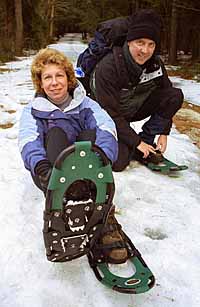
back

|
 |
Fitness-seeking boomers taking exercise outdoors
By Lisa Singhania, the Associated Press
January 5, 2004

When Jim Schakenbach is in the mood for a workout, he often bypasses the gym in favor of an afternoon of snowshoeing near his Massachusetts home."It's just a good cardiovascular workout," said
Schakenbach, 48. "It just helps you delay that softening of old age."
Many baby boomers like Schakenbach have decided to forgo aerobic workouts and countless hours spent on treadmills. They are looking for new ways to stay in shape that are easier on their aching joints and compatible with their busy schedules.
As a result, more companies are tapping into the fitness needs of boomers -- the post-World War II generation of Americans born from 1946 to 1964 -- with everything from super-efficient exercise machines to new gear for sports once overlooked.
The Nautilus Group, which makes fitness machines for the home and gym, recently introduced a treadclimber -- a $2,000 hybrid treadmill and
stairclimber. The product was inspired by focus groups with boomers who said they wanted a low-impact workout that wouldn't take too much time.
Because boomers are more willing to spend money on exercise equipment than other generations, they represent an attractive market for companies like Nautilus.
"Something like 70 percent of disposable income in the United States is owned by baby boomers. So that's why we've targeted them," said Gregg
Hammann, president and chief executive of Nautilus.
At Gotham Bikes in New York, boomers are buying bicycles in the $300-plus range that are designed for comfort, rather than speed or racing. And they are diligent about safety, too, including helmets and bike lights with their purchases.
As for snowshoeing, Schakenbach isn't alone. He rediscovered the sport a few years ago and now regularly ventures out with his wife.
"If you can walk, you can snowshoe," he said. "It's great exercise, and you're not paying hundreds of dollars to buy lift tickets. If I've got some time on a weekend, I can just say let's take three hours and go explore this meadow or mountain we've never been to."
The number of people snowshoeing has grown from 440,000 in 1994 to nearly 6 million today, with 49 percent of snowshoers ages 35 to 59, according to Kathy Tubbs, general manager of Tubbs Snowshoe Co. in Stowe, Vt. She says that growth has been helped by design changes in the sport; snowshoes have evolved from the clunky wood and deerhide models to lightweight aluminum frames customized to fit even the most petite athletes.
And Tubbs now is targeting its marketing at boomers. It has partnered with the Susan G. Komen Breast Cancer Foundation to increase awareness of the disease and is sponsoring family races that appeal to boomers looking to spend more time with children.
For those boomers who still fancy running, even road-race organizers are trying to capture their attention -- and their pocketbooks. Increasingly, marathons are offering half-marathon and other less-intensive alternatives designed to appeal to boomers, who historically have been the core participants in marathons, which stretch beyond 26 miles.
The HP Houston Marathon recently introduced a half marathon and 5K event, and marathon managing director Steven Karpas expects both events eventually to eclipse the full marathon in popularity.
"When you offer a half marathon and 5K, you see entire families registering for the event, not just the marathoners," Karpas said. "This is also a way for boomers who have run marathons but don't want to do that anymore to still participate."
That's what Mike Robertson, 43, a veteran marathoner, did over Thanksgiving. He and his wife headed to Atlanta to run a half marathon, spending big on hotel, meals and entrance fees.
"It's a great way for us to see the town and get some exercise and vacation in," said the resident of Mount Pleasant, S.C.
Copyright © 2002
Global Action on Aging
Terms of
Use | Privacy
Policy | Contact Us
|

